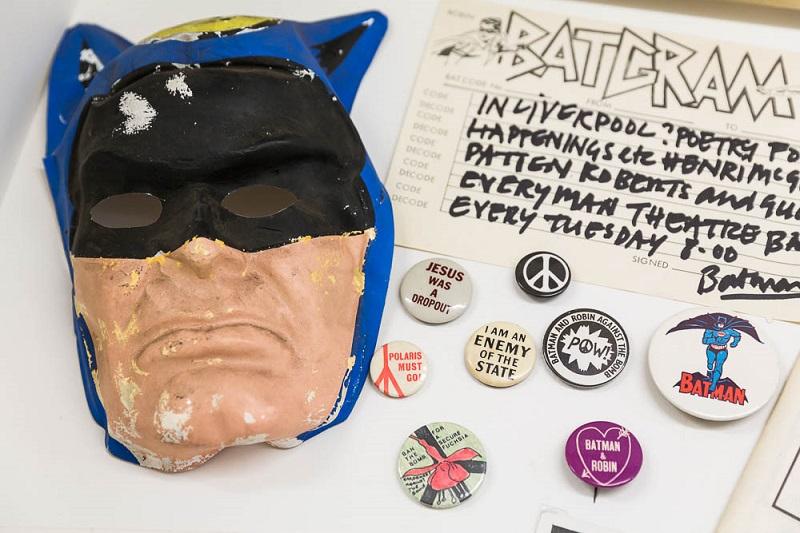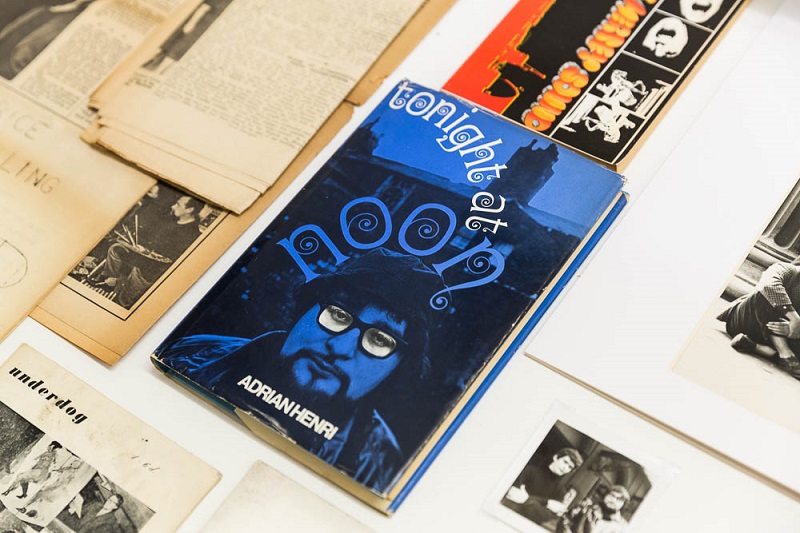First Happenings: Adrian Henri in the ’60s and ’70s, ICA | reviews, news & interviews
First Happenings: Adrian Henri in the ’60s and ’70s, ICA
First Happenings: Adrian Henri in the ’60s and ’70s, ICA
Love is... the Mersey Sound poet who was really a painter and performance artist

If you bought a Beatles album in the Sixties, chances are you also bought The Mersey Sound, that best-selling collection of poems by the Liverpool poets Brian Patten, Roger McGough and Adrian Henri. It was launched at the Cavern Club in 1967 to musical accompaniment. Their poems felt new, accessible and exciting. "Love is feeling cold in the back of vans," wrote Henri, "Love is a fanclub with only two fans / Love is walking holding paintstained hands / Love is /."
But though he was best known as a poet, Henri was primarily a painter, as well as a collage-maker and performance artist. He taught at Liverpool Art College, having studied at Newcastle under Richard Hamilton, who remained an influence, as did Kurt Schwitters and Allan Kaprow, the American Happenings inventor. Kaprow’s How to Make a Happening, recorded in 1966, lays out, rather bossily, 11 rules for how to do it right (steer clear of art and culture, keep boundaries blurry, don’t rehearse, give up the idea of putting on a show, use real places and people and don’t rely too much on imagination).
 This small exhibition at the ICA is like a time-capsule – those confusing, tumultuous times captured under glass. It’s slightly dizzying, peering in at the artefacts 50 or so years on. Happenings or events (he preferred the latter term, partly because Liverpool shops called sales "events", as in Furniture Event and Discount Event), said Henri, consisted of "what you couldn’t stick to a canvas – people, obviously, smells, music, perishable objects, places." He saw events as a direct transition from collage and started setting them up in 1962. City, put on in Liverpool that year, was probably the first such in England. The handwritten plans for it are here. Equipment was to include two tape recorders and a staple gun with music from a portable radio tuned to Radio Luxembourg (your station of the stars) and tapes with sound effects of the city. "Some painting, collage etc to be done during performance." The cast was to include a poet, a painter, a photographer, a stage manager, a man in mask (in audience), and an electrician.
This small exhibition at the ICA is like a time-capsule – those confusing, tumultuous times captured under glass. It’s slightly dizzying, peering in at the artefacts 50 or so years on. Happenings or events (he preferred the latter term, partly because Liverpool shops called sales "events", as in Furniture Event and Discount Event), said Henri, consisted of "what you couldn’t stick to a canvas – people, obviously, smells, music, perishable objects, places." He saw events as a direct transition from collage and started setting them up in 1962. City, put on in Liverpool that year, was probably the first such in England. The handwritten plans for it are here. Equipment was to include two tape recorders and a staple gun with music from a portable radio tuned to Radio Luxembourg (your station of the stars) and tapes with sound effects of the city. "Some painting, collage etc to be done during performance." The cast was to include a poet, a painter, a photographer, a stage manager, a man in mask (in audience), and an electrician.
Large, bearded, black-spectacled, here he is, in black and white TV footage declaiming his ironic Batpoem to music from the Liverpool Scene, with his band: "Help us smash the Vietcong / Batman / Help us show them that they’re wrong / Batman / Help us spread democracy / Get them high on LSD / Make them just like you and me / Batman /." There’s his Batmask (main picture), along with a Batcomposition collage and a catalogue for a comic exhibition at the ICA in 1970 that featured Henri along with Jules Feiffer, Stan Lee and others. And an extraordinary painting, the Sgt Pepper-like Entry of Christ into Liverpool in 1964, is an homage to James Ensor’s Entry of Christ into Brussels in 1889, featuring Henri’s heroes and friends: Pere Ubu, William Burroughs, Charlie Parker, Charles Mingus, George Melly, and Patten and McGough among others.
 The many posters provide a guided tour of an era: Love Night – lots of pink hearts – at the Everyman Theatre in Liverpool; the Amazing Adventures of the Liverpool Scene, with an album produced by John Peel, who called him one of the great non-singers of our time (the Liverpool Scene were on the bill at Pop Proms at the Royal Albert Hall In 1969, along with Led Zeppelin and Blodwyn Pig); an Apollinaire night at the ICA in 1968, also featuring Michael Kustow, then director of the ICA and who often put on Henri’s work. Letters, singles, badges, photos vie for attention. In one, Henri wraps Yoko Ono in bandages for her Fog Piece at the Bluecoat in Liverpool in 1967.
The many posters provide a guided tour of an era: Love Night – lots of pink hearts – at the Everyman Theatre in Liverpool; the Amazing Adventures of the Liverpool Scene, with an album produced by John Peel, who called him one of the great non-singers of our time (the Liverpool Scene were on the bill at Pop Proms at the Royal Albert Hall In 1969, along with Led Zeppelin and Blodwyn Pig); an Apollinaire night at the ICA in 1968, also featuring Michael Kustow, then director of the ICA and who often put on Henri’s work. Letters, singles, badges, photos vie for attention. In one, Henri wraps Yoko Ono in bandages for her Fog Piece at the Bluecoat in Liverpool in 1967.
There’s a fascinating letter on thin airmail paper from Allan Kaprow addressed to Dear Mr Henri: "I think your idea of working with the local environment directly is important. The hard job is to gently sidestep the arty crowd and keep your big toe deep in the ground. It’s hard because arty types seem to be supportive…but at bottom all they want is good taste and this is equated with fashion. The job… is to ride in and above the world all at once; the communication systems no longer permit anyone to be alone." And this was in 1966! "And don’t think you have to recreate America," Kaprow goes on. "It’s not good for you or Liverpool."
Henri remained firmly grounded in Liverpool. Not for him the fashionable London scene embraced by McGough and Patten. And Liverpool was where he met Catherine Marcangeli, the French curator of this exhibition and surely the world’s greatest Henri expert. Love Is… could have been written for her. She met him in 1986 when she was 19, travelling in England before university, and they were together, off and on and long-distance, for 15 years, while she forged a brilliant academic career in France and New York. She was 35 years younger than him and when he had a heart-bypass in 1999 followed by a series of strokes, she commuted from her job as a senior lecturer in art history at Paris-Diderot University to look after him and encourage him to keep working. She’s the executor of his estate (he died in 2000) and has catalogued his Total Art archive as well as editing collections of his poetry and curating exhibitions of his work.
- First Happenings: Adrian Henri in the ‘60s and ‘70s at the ICA until 15 March
- Adrian Henri: Performance, Environments and Happenings at the ICA cinema, 28 February. A panel explores Henri's work in poetry, music and art
Share this article
Add comment
The future of Arts Journalism
You can stop theartsdesk.com closing!
We urgently need financing to survive. Our fundraising drive has thus far raised £49,000 but we need to reach £100,000 or we will be forced to close. Please contribute here: https://gofund.me/c3f6033d
And if you can forward this information to anyone who might assist, we’d be grateful.

Subscribe to theartsdesk.com
Thank you for continuing to read our work on theartsdesk.com. For unlimited access to every article in its entirety, including our archive of more than 15,000 pieces, we're asking for £5 per month or £40 per year. We feel it's a very good deal, and hope you do too.
To take a subscription now simply click here.
And if you're looking for that extra gift for a friend or family member, why not treat them to a theartsdesk.com gift subscription?
more Visual arts
 'We are bowled over!' Thank you for your messages of love and support
Much-appreciated words of commendation from readers and the cultural community
'We are bowled over!' Thank you for your messages of love and support
Much-appreciated words of commendation from readers and the cultural community
 Folkestone Triennial 2025 - landscape, seascape, art lovers' escape
Locally rooted festival brings home many but not all global concerns
Folkestone Triennial 2025 - landscape, seascape, art lovers' escape
Locally rooted festival brings home many but not all global concerns
 Sir Brian Clarke (1953-2025) - a personal tribute
Remembering an artist with a gift for the transcendent
Sir Brian Clarke (1953-2025) - a personal tribute
Remembering an artist with a gift for the transcendent
 Emily Kam Kngwarray, Tate Modern review - glimpses of another world
Pictures that are an affirmation of belonging
Emily Kam Kngwarray, Tate Modern review - glimpses of another world
Pictures that are an affirmation of belonging
 Kiefer / Van Gogh, Royal Academy review - a pairing of opposites
Small scale intensity meets large scale melodrama
Kiefer / Van Gogh, Royal Academy review - a pairing of opposites
Small scale intensity meets large scale melodrama
 Jenny Saville: The Anatomy of Painting, National Portrait Gallery review - a protégé losing her way
A brilliant painter in search of a worthwhile subject
Jenny Saville: The Anatomy of Painting, National Portrait Gallery review - a protégé losing her way
A brilliant painter in search of a worthwhile subject
 Abstract Erotic, Courtauld Gallery review - sculpture that is sensuous, funny and subversive
Testing the boundaries of good taste, and winning
Abstract Erotic, Courtauld Gallery review - sculpture that is sensuous, funny and subversive
Testing the boundaries of good taste, and winning
 Edward Burra, Tate Britain review - watercolour made mainstream
Social satire with a nasty bite
Edward Burra, Tate Britain review - watercolour made mainstream
Social satire with a nasty bite
 Ithell Colquhoun, Tate Britain review - revelations of a weird and wonderful world
Emanations from the unconscious
Ithell Colquhoun, Tate Britain review - revelations of a weird and wonderful world
Emanations from the unconscious
 Rachel Jones: Gated Canyons, Dulwich Picture Gallery review - teeth with a real bite
Mouths have never looked so good
Rachel Jones: Gated Canyons, Dulwich Picture Gallery review - teeth with a real bite
Mouths have never looked so good
 Yoshitomo Nara, Hayward Gallery review - sickeningly cute kids
How to make millions out of kitsch
Yoshitomo Nara, Hayward Gallery review - sickeningly cute kids
How to make millions out of kitsch
 Hamad Butt: Apprehensions, Whitechapel Gallery review - cool, calm and potentially lethal
The YBA who didn’t have time to become a household name
Hamad Butt: Apprehensions, Whitechapel Gallery review - cool, calm and potentially lethal
The YBA who didn’t have time to become a household name

Comments
The Andrian Henri review